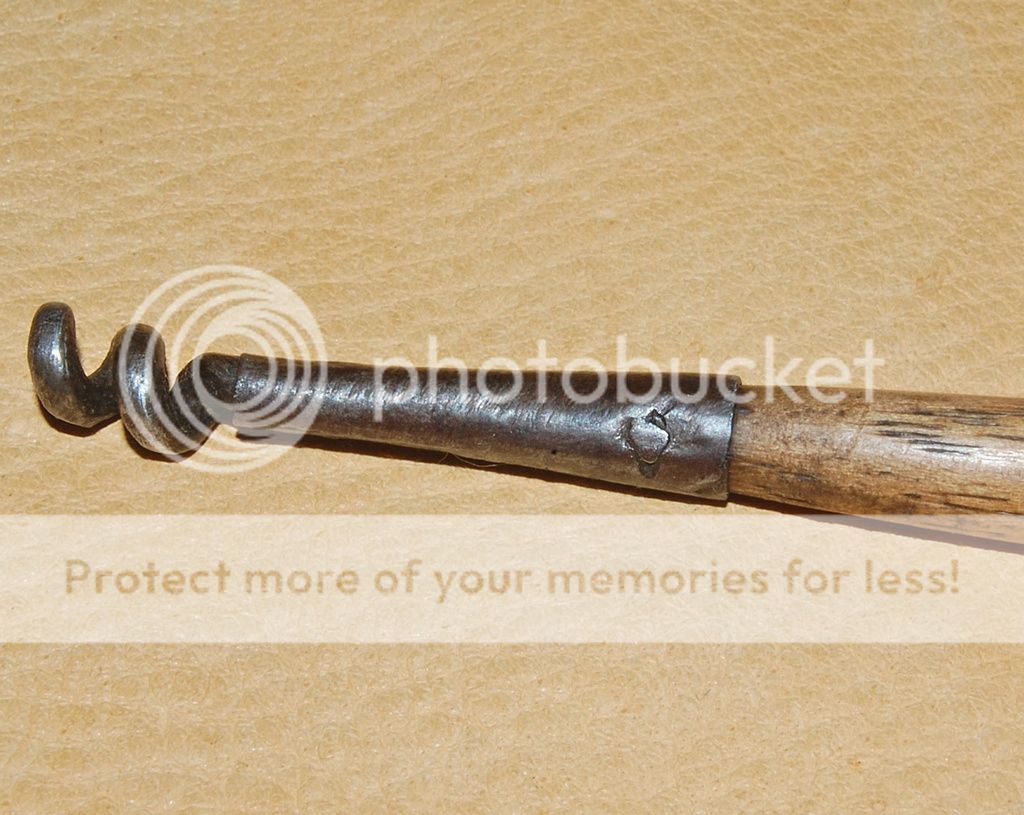-
Friends, our 2nd Amendment rights are always under attack and the NRA has been a constant for decades in helping fight that fight.
We have partnered with the NRA to offer you a discount on membership and Muzzleloading Forum gets a small percentage too of each membership, so you are supporting both the NRA and us.
Use this link to sign up please; https://membership.nra.org/recruiters/join/XR045103
You are using an out of date browser. It may not display this or other websites correctly.
You should upgrade or use an alternative browser.
You should upgrade or use an alternative browser.
18th Cen Ball Puller
- Thread starter mod98
- Start date

Help Support Muzzleloading Forum:
This site may earn a commission from merchant affiliate
links, including eBay, Amazon, and others.
Wood type screws were invented in the 1st century so they were available in the 1700s and 1800s.
Yes screws have been around for millennia. Let me be more specific. In the 1700s what did the tool look like? The few original loading sticks I have seen were either of wood alone or had a affixed metallic ramming tip that was solid. So we're ball pullers a separate rod all together with a screw end, was a screw tip affixed in such a way so as not to separate under stress of extraction..etc...
- Joined
- May 6, 2014
- Messages
- 17,085
- Reaction score
- 15,730
I assume you mean an 18th century Ball Puller for a gun with a Wooden Ramrod? These were known as both “Ball Screws” (most commonly) and “Ball Pullers” (less common, but still used) in the period.
“Christiansbrunn, the 9th September, 1773
Most valued Friend Martin Baer,
At your request I have prepared [completed/finished] a good rifle and sent it over to Mr. John Hopson together with 4 pounds of Powder. The rifle is decorated [inlaid] with silver wire and well made, as well as tested and she shoots right well. It has a double trigger, so that you can fire with the triggers either unset or set. Between the triggers there is a screw with which you can make it lighter or harder to fire. There is also a ball puller with which you can pull the ball out no matter how rusty she gets. She costs 8 pounds all together and with the powder @ 3 shillings per pound makes twelve shillings, for a total of L8.12.-. Because it is very good powder I have added two pounds more than you requested. I hope it will suit you well. You can write me a couple lines to let me know how you like it. Together with friendliest greetings I am your faithful
friend and servant,
Christian Oerter
Gunmaker”
http://flintriflesmith.com/WritingandResearch/WebArticles/1773 Letter from Gunmaker.htm
I have studied and actually owned 18th and 19th Century Ball Screws, but those were Military Ones and made for an Iron/Steel Rammer. I have never personally seen an original Ball Screw/Puller for a civilian gun with a Wood Ramrod, so most of this information relies on what others have passed on.
Though the below original Ball Screw is actually an early 19th century one, it gives an excellent view of the tapered screw found on the ends of period Ball Screws/Pullers. A tapered screw like this one holds the ball firmly and continues to get a better grip, the more you screw it into the lead ball. These are much, MUCH better than many of the modern style screws that have the threads at the same diameter down the length of the screw and will more likely strip in the soft lead of a ball. http://thumbs4.ebaystatic.com/d/l800/pict/311401523716_1.jpg
I don’t know of an illustration of an original 18th century Ball Screw/Puller, so I hope you will pardon me for providing a couple of examples of reproductions.
Below is a contemporary made reproduction set of a Worm and Ball Screw/Puller for a wooden ramrod. http://cabincreek.net/revspecs/tow-worm-ball-puller-set/
Below is a close up of another reproduction set: http://contemporarymakers.blogspot.com/2013_05_01_archive.html
There is not much information on the set above, but it is listed in this link: http://contemporarymakers.blogspot.com/2013_05_01_archive.html
Now, what is a bit harder to find is information on the Tips made for the Wooden Ramrod that these tools screw into. The modern threaded tips of uniform diameter and normally made from brass, were not what they used, but they are much more inexpensively made nowadays on machines.
As I understand it, the originals were often made of hand forged thin sheet iron in a sort of cone shape with a somewhat round “threaded nut” brazed into the cone on the end. The sheet iron was formed around a mandrel and brazed into a solid/open ended cone, IOW the cone did not have a point. To give you an idea what the “threaded nut” part looked like, think of a somewhat thin octagonal nut with the screw threads in it, but the originals were made with a rounded shape, though not perfectly round because they did not make them on a lathe. No need to go to the expense of turning that nut round on a lathe and they just hand filed them as round as possible. Now, these were normally attached to the rear end of the Ramrod that went inside the stock. They filed the end of the wood ramrod as close as possible to the inside shape of the cone. They may have used either hide glue or cutler’s glue in the period to help hold it on and they almost always would have drilled through the tip and ramrod, to insert an Iron Pin that was peened/riveted on each side of the Iron Cone. That Iron Pin really provided most of the ability to hold the tip on the end of the Wood Ramrod.
Perhaps someone else can find a link to one of these being made on the Internet. I have seen such a link, but can’t find it now.
Gus
“Christiansbrunn, the 9th September, 1773
Most valued Friend Martin Baer,
At your request I have prepared [completed/finished] a good rifle and sent it over to Mr. John Hopson together with 4 pounds of Powder. The rifle is decorated [inlaid] with silver wire and well made, as well as tested and she shoots right well. It has a double trigger, so that you can fire with the triggers either unset or set. Between the triggers there is a screw with which you can make it lighter or harder to fire. There is also a ball puller with which you can pull the ball out no matter how rusty she gets. She costs 8 pounds all together and with the powder @ 3 shillings per pound makes twelve shillings, for a total of L8.12.-. Because it is very good powder I have added two pounds more than you requested. I hope it will suit you well. You can write me a couple lines to let me know how you like it. Together with friendliest greetings I am your faithful
friend and servant,
Christian Oerter
Gunmaker”
http://flintriflesmith.com/WritingandResearch/WebArticles/1773 Letter from Gunmaker.htm
I have studied and actually owned 18th and 19th Century Ball Screws, but those were Military Ones and made for an Iron/Steel Rammer. I have never personally seen an original Ball Screw/Puller for a civilian gun with a Wood Ramrod, so most of this information relies on what others have passed on.
Though the below original Ball Screw is actually an early 19th century one, it gives an excellent view of the tapered screw found on the ends of period Ball Screws/Pullers. A tapered screw like this one holds the ball firmly and continues to get a better grip, the more you screw it into the lead ball. These are much, MUCH better than many of the modern style screws that have the threads at the same diameter down the length of the screw and will more likely strip in the soft lead of a ball. http://thumbs4.ebaystatic.com/d/l800/pict/311401523716_1.jpg
I don’t know of an illustration of an original 18th century Ball Screw/Puller, so I hope you will pardon me for providing a couple of examples of reproductions.
Below is a contemporary made reproduction set of a Worm and Ball Screw/Puller for a wooden ramrod. http://cabincreek.net/revspecs/tow-worm-ball-puller-set/
Below is a close up of another reproduction set: http://contemporarymakers.blogspot.com/2013_05_01_archive.html
There is not much information on the set above, but it is listed in this link: http://contemporarymakers.blogspot.com/2013_05_01_archive.html
Now, what is a bit harder to find is information on the Tips made for the Wooden Ramrod that these tools screw into. The modern threaded tips of uniform diameter and normally made from brass, were not what they used, but they are much more inexpensively made nowadays on machines.
As I understand it, the originals were often made of hand forged thin sheet iron in a sort of cone shape with a somewhat round “threaded nut” brazed into the cone on the end. The sheet iron was formed around a mandrel and brazed into a solid/open ended cone, IOW the cone did not have a point. To give you an idea what the “threaded nut” part looked like, think of a somewhat thin octagonal nut with the screw threads in it, but the originals were made with a rounded shape, though not perfectly round because they did not make them on a lathe. No need to go to the expense of turning that nut round on a lathe and they just hand filed them as round as possible. Now, these were normally attached to the rear end of the Ramrod that went inside the stock. They filed the end of the wood ramrod as close as possible to the inside shape of the cone. They may have used either hide glue or cutler’s glue in the period to help hold it on and they almost always would have drilled through the tip and ramrod, to insert an Iron Pin that was peened/riveted on each side of the Iron Cone. That Iron Pin really provided most of the ability to hold the tip on the end of the Wood Ramrod.
Perhaps someone else can find a link to one of these being made on the Internet. I have seen such a link, but can’t find it now.
Gus
Last edited by a moderator:
Larry Callahan is also making contemporary versions of the ball pullers and tow worms. And on the second page he also shows the ramrod tips.
Larry Callahan - Bag Molds and Accessories
Larry Callahan - Bag Molds and Accessories
- Joined
- May 6, 2014
- Messages
- 17,085
- Reaction score
- 15,730
Really good info on the "Ramrod Ends" as he calls them. Thank you!
Gus
Gus
Not a puller and not 18th-century, but this original mid-19th-century worm may illustrate the method they used to attach it to a wooden ramrod.Artificer said:As I understand it, the originals were often made of hand forged thin sheet iron in a sort of cone shape with a somewhat round “threaded nut” brazed into the cone on the end.
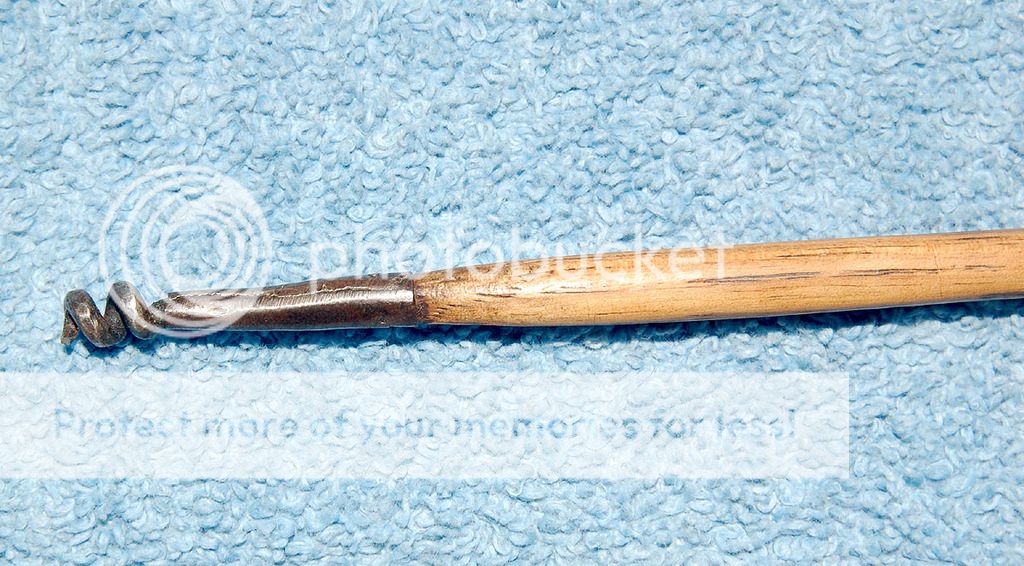
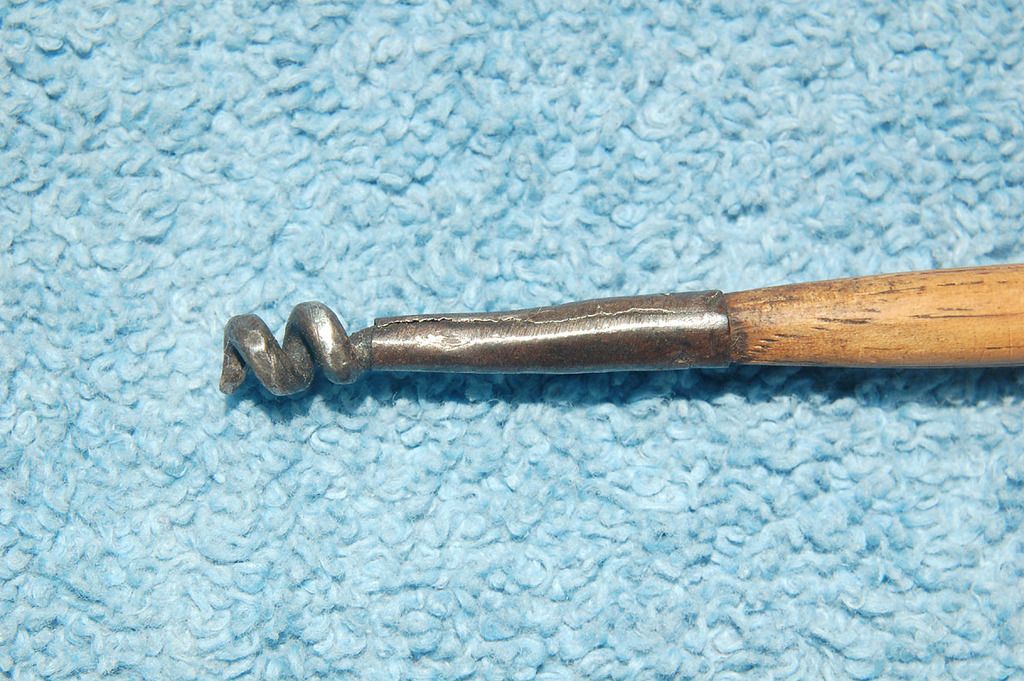
I have a reproduction combination worm and puller which may be a type I've seen advertised for sale in the 18th century. It requires a threaded tip on your wooden ramrod, of course.
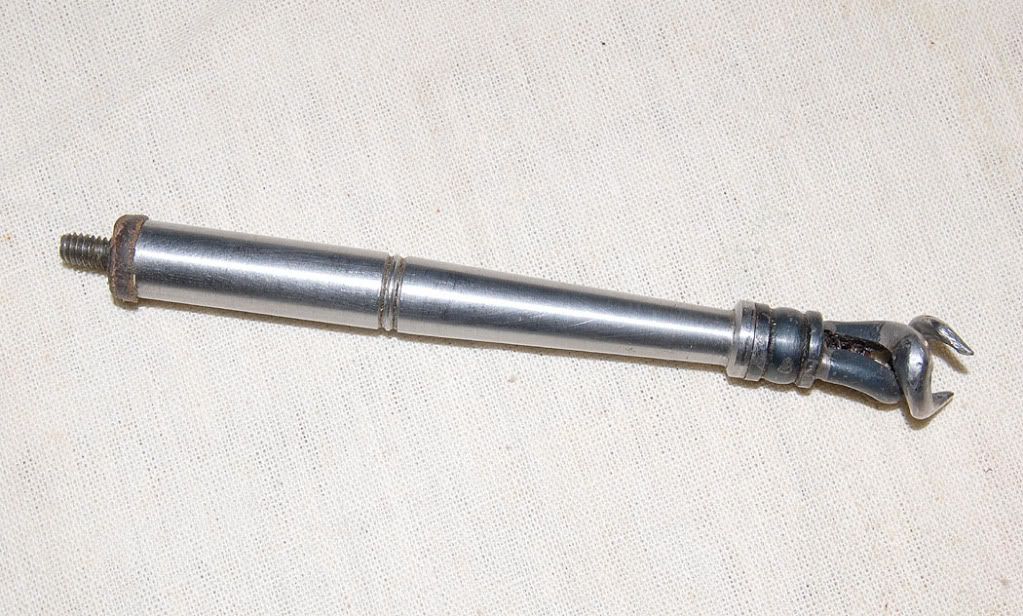
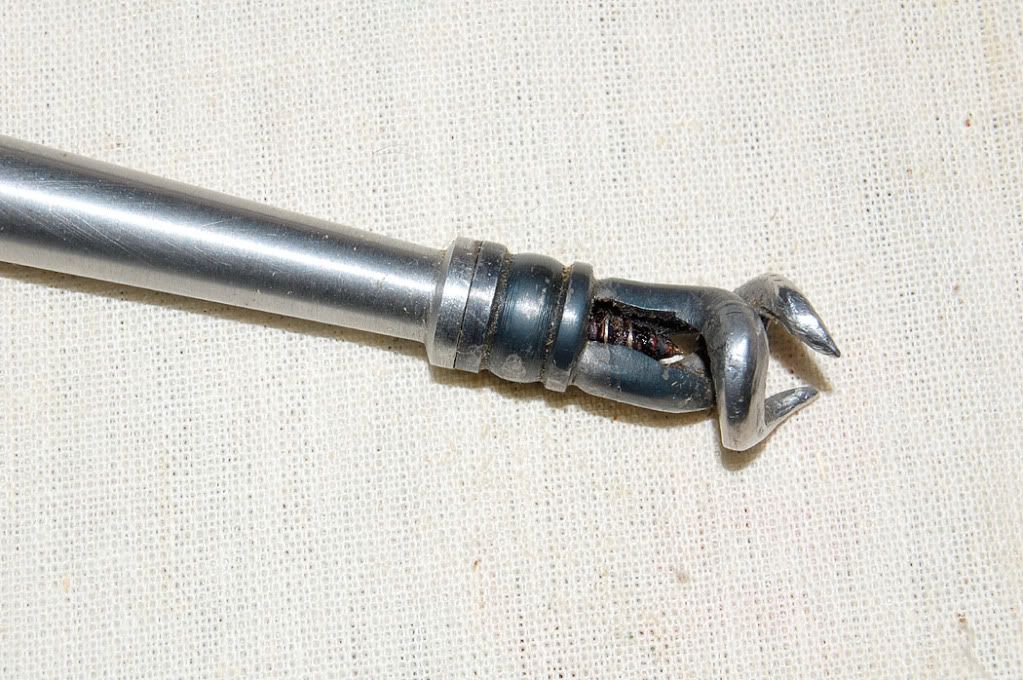
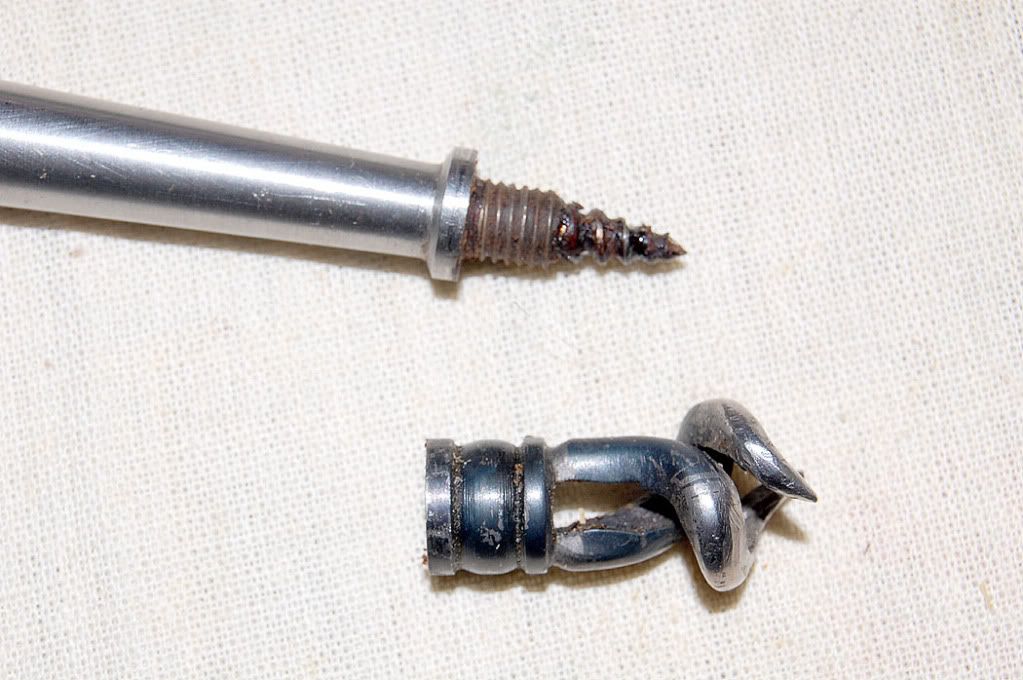
Spence
In 1772 Charles Carroll ordered two guns, and said for each:
"Direct the stocks near the muzles to be neatly capped with Brass (that part of the stock being very apt to split) and Screws neatly & strongly fixed with the end of each gun stick to draw the gunns.
Spence
N.B. This is the ad I was thinking of which could be describing the combination worm-puller in my last post.
The Pennsylvania Gazette
September 29, 1768
Just imported in the last vessels from London and Bristol,....key hooks, swivels and rings, single and double wormed gun screws, gun mounting, pocket and compass dials, fire steels,...
"Direct the stocks near the muzles to be neatly capped with Brass (that part of the stock being very apt to split) and Screws neatly & strongly fixed with the end of each gun stick to draw the gunns.
Spence
N.B. This is the ad I was thinking of which could be describing the combination worm-puller in my last post.
The Pennsylvania Gazette
September 29, 1768
Just imported in the last vessels from London and Bristol,....key hooks, swivels and rings, single and double wormed gun screws, gun mounting, pocket and compass dials, fire steels,...
- Joined
- May 6, 2014
- Messages
- 17,085
- Reaction score
- 15,730
George said:Not a puller and not 18th-century, but this original mid-19th-century worm may illustrate the method they used to attach it to a wooden ramrod.Artificer said:As I understand it, the originals were often made of hand forged thin sheet iron in a sort of cone shape with a somewhat round “threaded nut” brazed into the cone on the end.

Spence,
First of all, that is a NEAT original Worm and thanks for showing it.
I do have a question, does it have some kind of pin to hold it on or is it held in place by being what looks like formed down behind a bump that is a bit further down towards the end of the ramrod? By forming it downward behind the bump that seems closer to the end, it would be harder to slip off? Not sure if I am describing that well?
Gus
- Joined
- May 6, 2014
- Messages
- 17,085
- Reaction score
- 15,730
George said:In 1772 Charles Carroll ordered two guns, and said for each:
"Direct the stocks near the muzles to be neatly capped with Brass (that part of the stock being very apt to split) and Screws neatly & strongly fixed with the end of each gun stick to draw the gunns.
Spence
N.B. This is the ad I was thinking of which could be describing the combination worm-puller in my last post.
The Pennsylvania Gazette
September 29, 1768
Just imported in the last vessels from London and Bristol,....key hooks, swivels and rings, single and double wormed gun screws, gun mounting, pocket and compass dials, fire steels,...
Spence,
You may well be correct and please don't construe that to mean I think you wrong. That combination worm over a screw is one neat piece of gear and well possible for the technology of the day.
However, there is also another possibility in that were also combination Worm and Ball Screws that did not separate. British Ordnance purchased these from about the middle 1760's until shortly after the AWI and then never used again. I have not run across documentation on why these were dropped from use, but it seems the common theory is they did not work nearly as well as a separate Ball Screw and Worm according to Bailey and some others.
I actually found an original British Military one on sale in the UK from I think from either Peter Dyson or Blackley and Son back in 1996. It looked something like the one in the following link, though the end opposite the tips of the screw and worm was more bulbous. Another good friend and fellow reenactor wanted it more than I did, so I gave it away years ago.
http://www.ssfirearms.com/proddetail.asp?prod=W15096&cat=55
Of course, BOTH of these types of combination screws and worms could have been in use during the period and may be what they meant?
Looking at yours, it seems it would accompany a better grade sporting piece like a fine fowler or other higher quality gun.
Gus
Last edited by a moderator:
It would be hard to tell from the ad which, if either, of the types was being offered. I have no documentation that mine is correct or that it ever existed, I just presented it as a possibility. I would assume, though, that if there were military and civilian types, the ad would be offering the civilian.
Spence
Spence
- Joined
- May 6, 2014
- Messages
- 17,085
- Reaction score
- 15,730
Spence,
Thanks for showing the pin. That is one very interesting original worm.
Chances are the ad you quoted was for a civilian type, good point.
Gus
Thanks for showing the pin. That is one very interesting original worm.
Chances are the ad you quoted was for a civilian type, good point.
Gus
Similar threads
- Replies
- 121
- Views
- 9K
Latest posts
-
-
-
-
-
-
Does anyone make/sell something like a snap cap cone to dry fire a revolver?
- Latest: Flintlock Whiskey
-
-
Do You Actually Use Your Expensive Custom Guns or Keep Them as Safe Queens?
- Latest: Flintlock Whiskey




